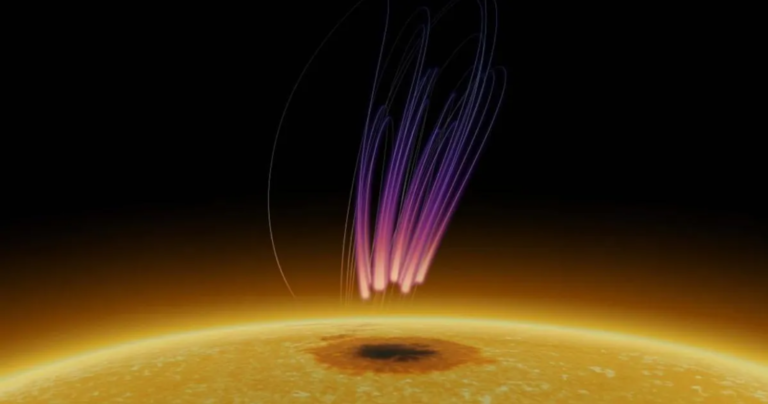‘Peculiar’ aurora-like radio signal from sunspot Detected for the First Time
This thrilling finding has the potential to reshape our understanding of magnetic processes in stars.
Solar scientists have witnessed a remarkable exhibition of radio waves above a sunspot, showcasing emissions that strikingly resemble Earth’s auroral displays, such as the Northern Lights. Manifesting approximately 25,000 miles (40,000 kilometers) above a dark, comparatively cool region on the sun, these “auroral” radio emissions have the potential to offer insights into the dynamics of intense solar radio bursts and shed light on large starspots beyond our solar system. Astronomers from the New Jersey Institute of Technology’s Center for Solar-Terrestrial Research (NJIT-CSTR) made this discovery.
Lead author of the research and a scientist at NJIT-CSTR, Sijie Yu, remarked, “We’ve detected a peculiar type of long-lasting polarized radio bursts emanating from a sunspot, persisting for over a week. This is quite unlike the typical, transient solar radio bursts typically lasting minutes or hours. It’s an exciting discovery that has the potential to alter our comprehension of stellar magnetic processes.”
While the most well-known auroral light shows occur on Earth, such as the Aurora Borealis or Aurora Australis (Northern and Southern Lights), similar displays are observed on other planets in our solar system, including Jupiter and Saturn, as well as distant stars. These displays on Earth result from solar activity impacting the planet’s magnetosphere, generating streams of charged particles that collide with atmospheric atoms like oxygen and nitrogen. When accelerated electrons travel down the Earth’s magnetic field lines, they can produce intense radio emissions at frequencies around a few hundred kilohertz.
The observed sunspot radio emissions, as noted by the team, originate in regions where the sun’s magnetic field lines are particularly robust. Additionally, these emissions differ from previously known solar radio noise storms in terms of their spectrum—the range of wavelength categories they encompass and the duration of those wavelengths.
How do sunspot auroras differ from Earth’s auroras?
The team proposes that this novel aurora-like phenomenon arises from the entrapment of high-energy electrons within converging solar magnetic fields, finding a conducive environment in the cooler and intensely magnetic regions of sunspots for the occurrence of electron-cyclotron maser (ECM) emissions.
“Unlike Earth’s auroras, these sunspot aurora emissions occur at frequencies ranging from hundreds of thousands of kHz to roughly 1 million kHz—a direct result of the sunspot’s magnetic field being thousands of times stronger than Earth’s,” explained Yu.
Furthermore, the team noted that the timing of these radio bursts appears unrelated to solar flares. Instead, sporadic flare activity in nearby active regions seems to inject energetic electrons into large-scale magnetic field loops anchored at the sunspot, fueling the ECM radio emission above the region, according to research co-author Rohit Sharma, a scientist at the University of Applied Sciences Northwestern Switzerland.
The rotation of the sunspot auroras synchronizes with solar rotation, creating a “cosmic lighthouse effect,” as described by Yu. “As the sunspot traverses the solar disk, it creates a rotating beam of radio light, similar to the modulated radio aurora we observe from rotating stars. As this sunspot radio aurora represents the first detection of its kind, our next step involves retrospective analysis. We aim to determine if some of the previously recorded solar bursts could be instances of this newly identified emission.”
These observations by the team establish a connection between solar behavior and magnetic phenomena around other stars. Ultimately, such studies have the potential to prompt solar physicists to reconsider existing models of stellar magnetism. “We’re beginning to piece together the puzzle of how energetic particles and magnetic fields interact in a system with the presence of long-lasting starspots, not just on our own Sun but also on stars far beyond our solar system,” noted research co-author and NJIT solar scientist Surajit Mondal.
The team’s research was published Monday (Nov. 13) in the journal Nature Astronomy.
Do not forget to share your opinion with us to provide you with the best posts !




0 Comments